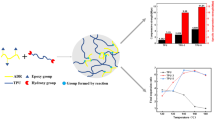Abstract
In this article, acrylonitrile (AN)/methacrylic acid (MAA)/acrylamide (AM) copolymer foam was prepared. DSC, TG and FTIR were adopted to analyze the chemical reactions in AN/MAA/AM copolymer foam, and confirm its molecule structure. SEM was employed to observe its cell structure, and the calculational method of resin distribution was founded basing on dodecahedron cell structural model. At last, its mechanical properties and thermal resistance were tested. The results indicate that cyclization reactions occur between adjacent AN/MAA units and MAA/AM units. Six-member imide rings, residuary MAA and AN units exist in main chains, and imide groups crosslink the chains. AN/MAA/AM copolymer foam has flat and closed cell walls with a high cell wall volume ratio. Cell wall volume ratios with the density of 32 kg/m3, 54 kg/m3 and 75 kg/m3 are 76%, 57% and 50% respectively. Because of rigid molecule structure and ideal cell structure, AN/MAA/AM copolymer foam possesses excellent mechanical properties and thermal resistance. As the densities are 32 kg/m3, 54 kg/m3 and 75 kg/m3, tensile strength are 1.00 MPa, 1.85 MPa and 2.30 MPa, compressive strength are 0.40 MPa, 1.00 MPa and 1.72 MPa, and shear strength are 0.45 MPa, 0.86 MPa and 1.29 MPa respectively. Heat distortion temperature of the copolymer foam is higher than 180 °C.












Similar content being viewed by others
References
Gibson LJ, Michael FA (1997) Cellular solids: structure and properties (2nd ed). Press syndicate of the University of Cambridge
Smits G (1994) Effect of cellsize reduction on polyurethane foam physical properties. J. Therm Insulation Building Envelopes 17:309–330
Martin N, Richard G (2003) Mechanical-morphology relationship of PS foams. J Cellular Plast 39:353–367
Martini JE, Waldman FA, Suh NP (1982) Production and analysis of microcellular thermoplastics foams. Annual technical conference-society of plastics engineers, San Francisco 674–676
Sun HL, Gil SS, James EM et al (2002) Microcellular foams from polyethersulfone and polyphenylsulfone preparation and mechanical properties. Eur Polym J 38:2373–2381. doi:10.1016/S0014-3057(02)00149-0
Williams MK, Holland DB, Melendez O et al (2005) Aromatic polyimide foams: factors that lead to high fire performance. Polym Degrad Stabil 88:20–27. doi:10.1016/j.polymdegradstab.2003.12.012
Cano CI, Weiser ES, Kyu T et al (2005) Byron Pipes. Polyimide foams from powder: Experimental analysis of competitive diffusion phenomena. Polymer (Guildf) 46:9296–9303. doi:10.1016/j.polymer.2005.07.056
Hedrick JL, Dipietro R, Plummer CJG et al (1996) Polyimide foams derived from a high Tg polyimide with grafted poly(α-methylstyrene). Polymer (Guildf) 37(23):5229–5236. doi:10.1016/0032-3861(96)00331-X
Servaty S, Geyer W, Rau N et al (2003) Method for producing block-shaped polymethacrylimide foamed materials, United States Patent, 6670405. 30th Dec
Hermann FS (1999) PMI rigid foam plastic. Kunstsoffe 89(4):32–33
Hermann FS (2000) PMI foam cores find further applications. Rein Plast 44(1):36–38. doi:10.1016/S0034-3617(00)86485-1
McGarva LD, Åström BT (1999) Experimental investigation of compression moulding of glass/PA12-PMI foam core sandwich components. Compos Part A 30:1171–1185. doi:10.1016/S1359-835X(99)00028-7
Suna HL, James EM, Tan SC et al (2005) Microcellular foams from some high-performance composites. Polymer (Guildf) 46:6623–6632. doi:10.1016/j.polymer.2005.05.016
Mahfuz H, Rangari VK, Islam MS et al (2004) Fabrication, synthesis and mechanical characterization of nanoparticles infused polyurethane foams. Compos Part A 35(4):453–460. doi:10.1016/j.compositesa.2003.10.009
Chen T, Zhang GC, Liu TM (2006) Preparation and characterization of acrylonitrile/ methacylic acid copolymer foam. China Plast 20(3):70–74
Zhou WZ, Wang XS (2003) Main mechanical properties of foamed plastics and its mechanical model. Plast Sci & Tech 6:17–19
Liu C, Chuang CK, Tsiang RC (2004) Foaming of Electron-Beam Irradiated LDPE Blends Containing Recycled Polyethylene Foam. J Polym Res 11:149–159. doi:10.1023/B:JPOL.0000031081.29087.2f
Author information
Authors and Affiliations
Corresponding author
Rights and permissions
About this article
Cite this article
Ting, C., Guangcheng, Z. & Xihao, Z. Structure and properties of AN/MAA/AM copolymer foam plastics. J Polym Res 17, 171–181 (2010). https://doi.org/10.1007/s10965-009-9303-x
Received:
Accepted:
Published:
Issue Date:
DOI: https://doi.org/10.1007/s10965-009-9303-x




